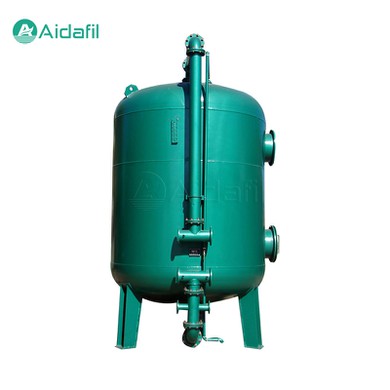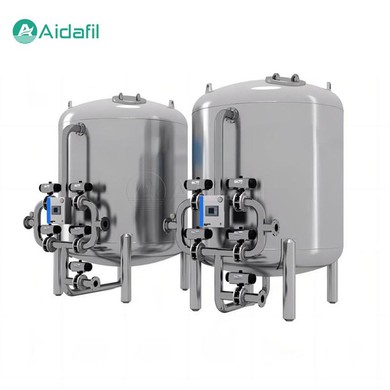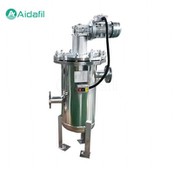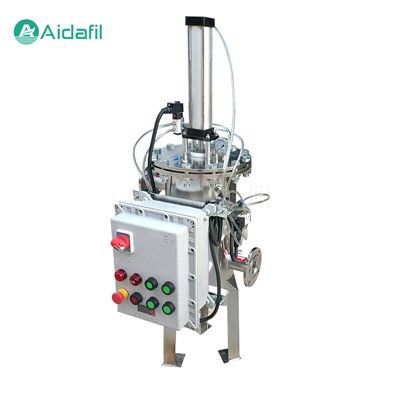
Large Capacity Vertical Placed Sand Filter
Product Details
The Large Capacity Vertical Placed Sand Filter is a device that uses homogeneous quartz sand of equal particle size as filter material to achieve deep filtration by building a three-dimensional sand bed. This three-dimensional filtration structure gives it a strong impurity retention ability, which is especially suitable for removing suspended particles in water, including organic and inorganic impurities, to ensure the cleanliness and safety of water quality.
Structural elements
1. Sand bed. The core component is layered with quartz sand of different particle sizes to form an effective filtration layer.
2. Container. Usually cylindrical or square, used to accommodate sand beds, made of stainless steel or fiberglass to ensure corrosion resistance.
3. Water inlet and outlet. The channel where water flows in and out, scientifically designed to ensure uniform distribution of water and effective filtration.
4. Backwash system. Used to regularly clean the sand bed to restore filtration efficiency.
Parameters
|
Working pressure |
0.05 ~ 1.0 MPa |
|
Working temperature |
0 ~ 40°C |
|
Flow |
0.5 m3/h ~ 140 m3/h |
|
Control mode |
Automatic or manual |
|
Dimension |
ф173 ~ ф3800 |
|
Filtering speed |
8 ~ 20 m/h |
|
Material |
Q235 rubber / phenolic epoxy resin / 304, 316L |
|
Backwash strength |
12 ~ 15 L/s. m2 |
|
Filtering layer resistance |
>0.05 MPa |
|
Backwash duration |
4 ~ 10 min |
|
Final turbidity |
≤3 |
Working principle: The mystery of three-dimensional deep filtration
1. Normal filtration process
When water containing impurities flows through the sand bed, the larger particles are first intercepted by the coarser sand grains on the surface. As the depth increases, the finer impurities are captured by the finer sand grains, and the water quality gradually clears under layer by layer filtration. This process reflects the "graded filtration" characteristics of the sand and gravel filter.
2. Backwash mechanism
Over time, a certain amount of impurities will accumulate on the sand bed, which affects the filtration efficiency. At this time, the backwashing mechanism starts, and the sand bed is initialized by rapid reverse water flow or gas-water mixed flow to discharge the trapped impurities and restore the filtration capacity of the sand bed. Reasonable backwashing cycle and strength are the keys to ensure the long-term and efficient operation of the sand and gravel filter.
Determinants: The trade-off between accuracy and effectiveness
1. Medium size
The particle size of the filter material directly affects the filtration accuracy. Small filter media can capture more tiny impurities, but it will also reduce the filtration speed and increase the water resistance; on the contrary, although the coarse filter media increases the filtration speed, it sacrifices the filtration accuracy.
2. Filtration rate
Too fast flow rate may cause impurities to penetrate the filter layer, reducing the filtration effect; too slow will reduce the amount of water treated. Finding the right filtration rate is the key to balancing efficiency and effectiveness.
3. Sand layer thickness
If the sand layer is too thin, it may not be able to effectively intercept impurities. If it is too thick, it will increase water head loss and affect system energy consumption. Reasonable setting of sand layer thickness is an important part of improving filtration efficiency.
Wide application: From field to industry
1. Agricultural irrigation. In agricultural micro-irrigation systems, sand filters can effectively remove sediment, algae and other impurities from water sources, protect drip irrigation and sprinkler irrigation equipment from blockage, and ensure irrigation efficiency and crop health.
2. Pool maintenance. Keep the pool water clear, remove suspended solids, reduce the use of chemical disinfectants, and enhance the swimming experience.
3. Industrial circulating water. In industrial cooling water circulation systems, sand filters can effectively remove suspended solids from circulating water, prolong equipment life, and reduce maintenance costs.
Maintenance and management: Ensuring long-term efficient operation
1. Regular inspection and backwashing. According to the water quality and frequency of use, develop a reasonable backwashing plan to avoid clogging of the filter material layer.
2. Filter media replacement. After long-term use, some filter media may be worn or contaminated seriously, requiring regular inspection and timely replacement.
3. Monitoring water quality. Continuously monitor the quality of incoming and outgoing water, and adjust filtration parameters in a timely manner to adapt to changes in water quality.
4. Equipment cleaning and inspection. Regularly clean and inspect the filter casing, pipes and accessories to prevent corrosion and leakage.
FAQ
1. Q: What is the function of a filter?
A: The main function of a filter is to remove solid particles, impurities, and harmful substances from liquids or gases, in order to achieve purification, clarification, and protection of equipment.
2. Q: How to choose a suitable filter?
A: When choosing a filter, factors such as the properties of the material being filtered (e.g., viscosity, temperature, corrosion), required filtration accuracy, processing capacity, operating pressure and medium, as well as the type, material, size, and installation method of the filter should be considered.
3. Q: What is the working principle of a filter?
A: The working principle of a filter mainly relies on physical screening, deep interception, absorption, or chemical reactions to remove impurities or harmful components from the material being filtered.
4. Q: How to maintain and care for a filter?
A: Maintenance of filters includes regular cleaning or replacement of filter elements, inspection of seals and fasteners, maintaining stable operating pressure, and avoiding overloading. Specific methods should be referenced from the filter's instruction manual and maintenance guides.
5. Q: What is the service life of a filter?
A: The service life of a filter depends on its working environment, processing volume, and filtration accuracy. Generally, when the filter's pressure drop reaches a certain value or the filtration effect decreases significantly, it needs to be replaced or cleaned.
6. Q: What should be paid attention to during filter installation?
A: During filter installation, attention should be paid to the directionality, ensuring that the fluid enters and exits from the correct ports. Also, the piping system should be cleaned before installation, and the filter should be securely fastened and sealed as required by the instructions.
7. Q: What is the replacement cycle for filters?
A: The replacement cycle for filters depends on their working conditions and filtration requirements, and is usually indicated by pressure difference indicators or timers. When the filter's pressure drop reaches the set value or the filtration effect decreases, it should be replaced in a timely manner.
Why Choose Us
· Professional manufacturer with many years' experience
· Good quality with competitive price
· OEM & ODM are welcome
· Various payment items are acceptable
· Good service by experienced manager
AIDA Philosophy
1. Management Concept:
· Satisfy the customers' demand --- Touch customers, trust with our products and services
· Make employees happy --- Pursue higher material and spiritual happiness
2. Company Mission:
· Focus on customer needs, provide best filtering solution
· To be the lifelong partner with customers
3. Corporate Vision:
· Become a global purification leadership brand
4. Values:
· Customer: Pursue the ultimate experience, enjoy excellent quality
· Team: Trust, responsibility, growth, win-win
· Work: Simple, sincere, efficient, dedicated
Hot Tags: large capacity vertical placed sand filter, China, factory, price, buy, high porosity sintered metal fiber felt, composite materials coalescer filter cartridge, easy maintenance stainless steel woven wire mesh, advanced screw compressor oil filter, duplex basket strainer against large particles, Air Compressor Oil Filter








